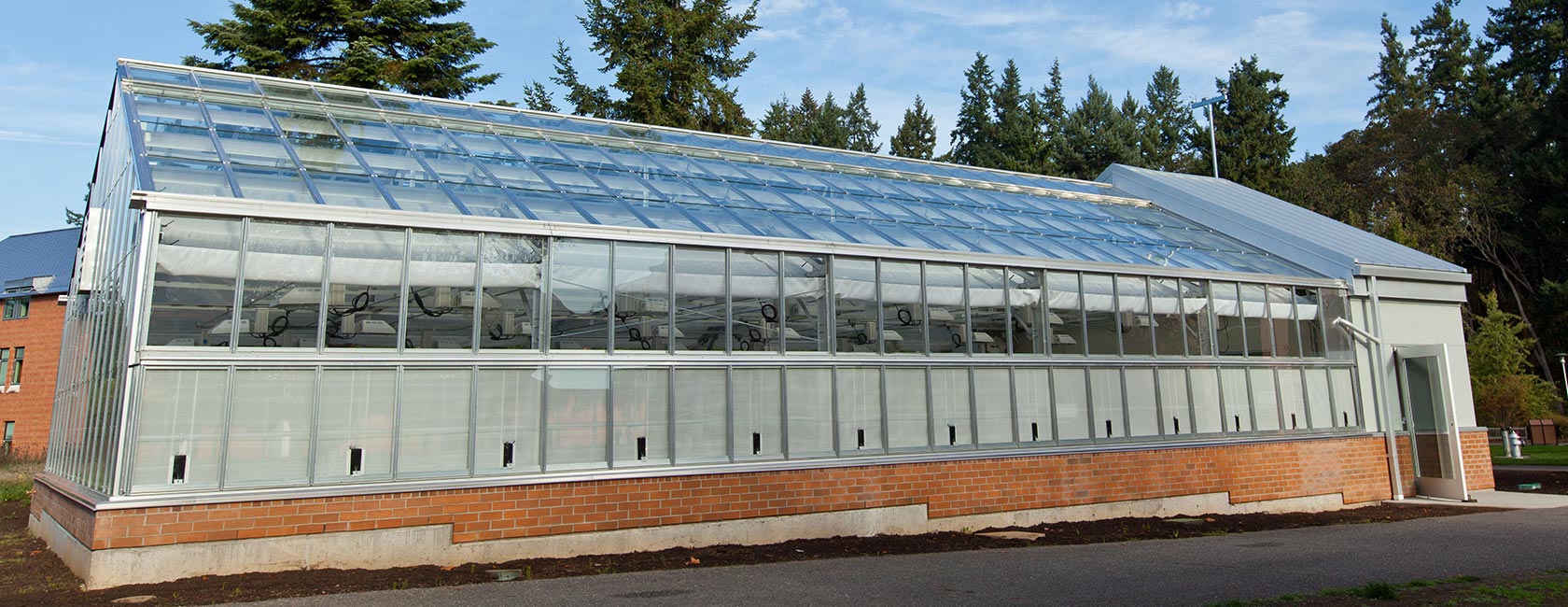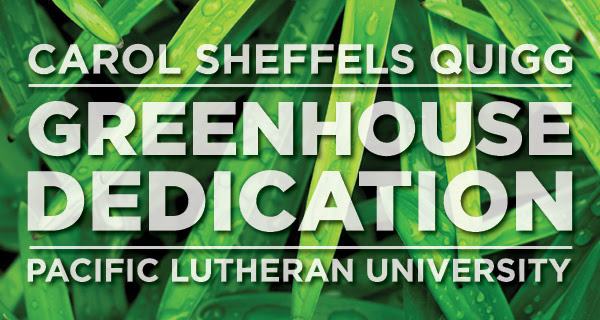PLU’s New Greenhouse is Growing Into Something Amazing

Image: PLU’s new Carol Sheffels Quigg Greenhouse will be dedicated Oct. 19. (Photo: John Froschauer/PLU)
UPDATE (10.15.15):
Please join the PLU community in dedicating the Carol Sheffels Quigg Greenhouse. A reception and opportunity to explore the greenhouse will follow the dedication ceremony. We hope to see you there!
Date: Monday, October 19, 2015
Time: 10:30 a.m.
Location: Between Rieke Science Center and Morken Center

By Matthew Salzano ’18
PLU Marketing & Communications
TACOMA, Wash. (March 20, 2015)—Just as spring springs, a new building has begun to peek out from the soil in lower campus: Pacific Lutheran University’s new greenhouse is starting to grow.
The 1,700-square-foot, stand-alone Carol Sheffels Quigg Greenhouse is expected to open early to mid-August, with a formal dedication in September 2015.
“It’s going to be a wonderful addition to the biology program at PLU by having a facility now that can showcase not only a plant collection but also give students the best place to be able to carry out experiments that involve plants,” said Associate Professor of Biology and Dean of Natural Sciences Matt Smith.
The state-of-the-art greenhouse will use an innovative, closed-loop geothermal energy system, which means that no greenhouse-gas-producing emissions will be used to heat and cool the building, and it also will fulfill curricular needs in the Biology Department—from first-year requirements to seniors engaged in upper-division study.
“We’ve been emphasizing plants in our curriculum because they’re an important model system,” Biology Chair Ann Auman said. “All different aspects of biology can be illustrated through the use of plants: small biology, genetics, molecular biology, organismal biology, ecology and evolution.”
Biology’s two-course introductory core sequence, for example, uses plants to introduce students to biological studies; an upper-division botany course is a requirement for Biology majors, and other upper-division courses including genetics and molecular biology incorporate plants as well. All of these courses are set to benefit from the new greenhouse.
This widespread use of plants means that, whether planning to be a botanist or a cardiologist, graduates will understand how important what’s growing in the dirt is to everyone.
“Not only do we eat plants every day, but everyone who’s had a sick child that you’ve wanted to give aspirin to, for example, has benefited from chemicals that came from a plant—aspirin came from willow, originally,” said Assistant Professor of Biology Romey Haberle. “Having all Biology majors take botany classes is because of our commitment as a liberal arts institution to educate the whole individual, and doctors, for example, need to understand all of biology.”
Additionally, the greenhouse will serve research needs and faculty/student collaborations. Professors such as Neva Laurie-Berry, Mary Ellard-Ivey and Haberle will benefit from more space to grow specimens for molecular analysis, ecological experiments and morphological studies.
In addition, the greenhouse will provide space for a botanical collection that shows biodiversity and representatives of major taxonomic groups from around the world, meaning it also will free up some space at Haberle’s home, where she grows some plants for her courses—inside, and on her porch, commuting with them when she needs them in class. With a greenhouse, plants like her beloved Amorphophallus konjac can live on campus without scaring prospective students away with its distinctive scent—rotting meat.
The greenhouse also will serve the campus community by providing space for growing vegetable garden starts for the PLU Community Garden and native plants for the PLU campus landscape. It also will serve as community outreach for the Division of Natural Sciences and the Biology Department. PLU is the host site for the Tacoma/South Puget Sound Math Engineering Science Achievement (MESA) program, so PLU hopes to have elementary-, middle- and high-school students use the greenhouse in the future to learn about the importance of plants.
The idea for building a new greenhouse began in the late 2000s, when the Department of Biology hired two new faculty members who were specifically interested in botany, and then-Biology Chair Smith realized they would not be properly equipped for their teaching and scholarship.
Currently, PLU’s facilities include a 325-square-foot greenhouse on the second floor of the Rieke Science Center, constructed with the building in 1985. This greenhouse is not adequate for proper instruction, Smith said: It has no climate control, so temperatures reach up to 120º during summer days; it is not large enough for classes; and it is not accessible to students.
In December 2010, PLU hired an external consultant who advised that a new greenhouse would be far more fiscally responsible than attempting to fix the current one.
Smith worked with PLU’s Office of Advancement to identify funds for the project. PLU donor Carol Sheffels Quigg made a significant gift toward the construction, and the rest of the funding came from other individual donors, retired faculty members and grants from the Murdock Trust and the Norcliffe Foundation.
The new greenhouse will be a very welcome asset to the PLU campus, Quigg told PLU’s student newspaper, The Mooring Mast.
“I come from a farm background and am very mindful of the extreme importance of plants in our lives,” Quigg said. “In short, they are essential to our lives.”
In December 2014, the project was funded at $880,000. In February, the Board of Regents granted permission to begin construction of the greenhouse between Rieke and the Morken Center for Learning and Technology, and construction began Feb. 18.
Westmark Construction and Precision Greenhouse Construction, Inc. are building the aluminum and glass-pane facility. After consultation with Horticulture Services, the greenhouse was designed by AustinCina Architects, based on a kit from NEXUS Greenhouse Systems.


